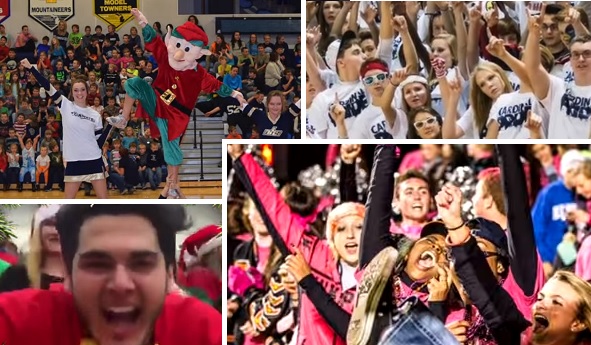
BOTF V: What You Taught Us
February 17, 2016
By Geoff Kimmerly
Second Half editor
We’ve completed our Battle of the Fans statewide tour for 2016, and hopefully you’ve kept up with our visits and learned why our five finalists are candidates to be known as the state’s top high school student section.
 But we appreciate as well the great student sections that entered the contest and weren’t chosen this time for the finalists tour. We try to teach sportsmanship and the best way to support your local teams – but all of our applicants taught us something again this winter.
But we appreciate as well the great student sections that entered the contest and weren’t chosen this time for the finalists tour. We try to teach sportsmanship and the best way to support your local teams – but all of our applicants taught us something again this winter.
Here’s a look at what we learned from the 17 student sections who didn’t make the BOTF Finals, but should be celebrated as well:
Tradition never graduates
Ann Arbor Gabriel Richard’s video took us through five years of its student section. The Fighting Irish were a BOTF finalist in 2013, and the section brings a strong effort every year although a new class of students joins each fall and a veteran group of leaders graduate each spring. Longevity and doing it right earns a lot of respect – not only from us, but surely in the community as well as the section has become such a prominent and positive part of student life at the school.
Get inspired
The Saginaw Michigan Lutheran Seminary student section was represented in a local contest last year by a photo of a few students sitting in the bleachers. Things had to change. Driven by the student council and a league Sportsmanship Summit, the Superfans were born – in fact, superfan became a verb to mean taking part. They’re off to a great start.
Wyoming Godwin Heights’ “Fred’s Fanatic Fans” also got their start this year as part of the Promote Enthusiastic Price (P.E.P.) Club, which was created to cheer on the school’s teams and “build the right climate.” We couldn’t have described the right goal better ourselves.
St. Johns was a finalist in 2015 even as leaders were still working to sway the entire student body toward a new, positive way of thinking and cheering. That movement continued to pay off this year; the Redwings were back, bigger and better, and we were glad to see it.
Be proud
Big Rapids has a few more than 600 students, but we could count at least 150 making up a rowdy crowd at a number of events used in the application video. Everything we could see pointed toward what has to be a blast in the stands.
 Fulton literally spelled out its drive on the screen: “Small Town, Small Teams, Big Hearts, Big Dreams.” The school has 200 students – and like finalist Munising, showed it can be done, filling the stands for a variety of games used in the video.
Fulton literally spelled out its drive on the screen: “Small Town, Small Teams, Big Hearts, Big Dreams.” The school has 200 students – and like finalist Munising, showed it can be done, filling the stands for a variety of games used in the video.
Manton’s Ranger Rowdies may number no more than 280 students, but they certainly bring the noise, literally, which was immediately obvious. Most of the student body had to be in attendance for the games they filmed.
Follow the leaders
Similar to finalist Traverse City West, Detroit U-D Jesuit’s section is driven by its student government. A student senate committee is dedicated to making the section (and whoever came up with the wrecking ball deserves a few more votes in the next election).
We know about the strength of Dowagiac’s leadership firsthand after awarding the section the BOTF 2015 championship. They had a lot of leaders showing the way last year, and that appeared to be true again – a favorite part was a line of students arm-in-arm in the front row, facing the rest of the section during a back-and-forth cheer. And the The Attack's chant shown below always will be a favorite.
Be creative
Tawas’ Brave Cave is full of ideas, starting with in-game interviews of students during an application “broadcast” by TSPN (Tawas Sports Programming Network). Tawas Proud, indeed, and for good reason.
Even if the “D” was upside-down at first on the line of placards spelling out the school’s name in the back row (which was funny), Wayland brought plenty to join the discussion of possible finalists. The “Den” was filled with costumes, signs, and just a lot of material that surely makes for a fun night.
For starters, Pontiac Notre Dame’s name – Irish Thunder – just sounds powerful. It was hard to tell what was going on as part of the “Whistle Cheer,” but it looked pretty wild, especially in front of what appeared to be a giant pep rally crowd (See below).
Involve everyone
Walled Lake Western’s video included interviews with parents and basketball players as well, and one of the athletes said something that especially stuck out: “They cheer the other team and us on.” That’s taking inclusion to another level, and we applaud it.
Utica Ford’s leaders spoke during its application about how the student section was like something bigger than the school itself – something they all have together. And that’s a great thing. (The student section flag was a cool touch as well.)
Holland’s Dutch Nation leaders take getting everyone involved to the highest level, incorporating the pep band and cheerleaders during games and the athletic director and many others at the school behind the scenes. As one said, “We work to spread participation not only for the students, but the whole community.”
Imlay City’s Spartan Nation made shirts like many student sections, but didn’t reserve them for high school students alone – they made them for elementary and middle schoolers and sold to the greater community as well in an effort to get everyone together. (And bringing in Santa Claus for a Christmas-themed game for the younger kids was a neat idea too.)
Ending on one last strong note, we hope Norway is just beginning its BOTF quest. #UKNIGHTED might be the best campaign of BOTF V. They’re “all knights and all united,” and set a great example of getting a community together.
Click to watch all 22 application videos for this year's Battle of the Fans V.

NFHS Voice: Respect Everyone
November 4, 2019
By Karissa Niehoff
NFHS Executive Director
Case studies have revealed that kids want to participate in high school sports because they are fun. Being a part of a team gives them an identity, a sense of self-worth and, in some cases, a reason for engaging in academics. They are included, accepted and feel like a valued member of a community.
This describes the ideal and the goal of high school sports. Fortunately, that atmosphere exists at a majority of the 19,500-plus high schools within the NFHS family. And since it is the desire of high school leadership throughout the country that these ideals continue, we are concerned about the growing decline in respect, integrity and unacceptable behavior in and around high school sports.
Racism is one of our greatest concerns nationwide. We have heard of students posting videos to social media with racist comments. We read about racial comments by team members of nearly all-white schools to opposing players from schools composed of nearly all minority students. There have been cases of white players disrespecting Native American players on the opposing team by addressing them in an unacceptable manner.
This type of behavior could be a reflection of events occurring in our society, or due to lack of a respectful environment at home. Regardless, they are not defensible reasons for the occurrence of these horrible acts within education-based high school sports and activities.
High school sports and activities exist to lift people up, not demean or tear people down. National politics or lack of role modeling by adults at home aside, coaches, administrators and other leaders in high schools nationwide must direct programs with respect, acceptance and dignity and demand the same from the school participants.
More than 50 years ago, Special Olympics began a global movement to break down barriers and end discrimination against people with intellectual disabilities. Since then, lives have been changed for the better all around the world. Many schools have implemented Unified programs in sports, performing arts and even physical education.
We must do the same for everyone. All student-athletes – regardless of race, religion, political views or gender identity – should be treated equally. As baseball Hall of Famer Jackie Robinson said, “I’m not concerned with your liking or disliking me. ... All I ask is that you respect me as a human being.”
As schools hire individuals to fill coaching positions, character must be the top prerequisite for the job. They must be guided by honesty, integrity and ethics, and they must be positive role models for students. And this is certainly not a new idea.
H. V. Porter, the first full-time executive director of the NFHS, had the following to say in 1950: “The amount of success (in improving sportsmanship) is largely dependent on the degree to which attention is constantly given to the matter by the school staff.”
We certainly agree with Mr. Porter but also believe that everyone must pay attention.
The NFHS has several free online education courses through the Learning Center (www.NFHSLearn.com) that can assist in establishing a program that teaches and models respect for self and respect for others. We suggest that “Teaching and Modeling Behavior,” “Sportsmanship” and “Bullying, Hazing and Inappropriate Behaviors” be required courses for everyone working with student-athletes.
High schools must establish a culture that values the worth of every single person – both players on the school’s team and players on the opposing team. There must be a no-tolerance policy regarding behavior that shows disrespect for another individual.
Kids today are looking for a community, and high school sports and activities must be that community that is fun, respectful and supportive of everyone.
Dr. Karissa L. Niehoff is in her second year as executive director of the National Federation of State High School Associations (NFHS) in Indianapolis, Indiana. She is the first female to head the national leadership organization for high school athletics and performing arts activities and the sixth full-time executive director of the NFHS, which celebrated its 100th year of service during the 2018-19 school year. She previously was executive director of the Connecticut Association of Schools-Connecticut Interscholastic Athletic Conference for seven years.

